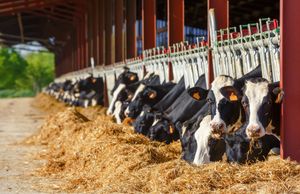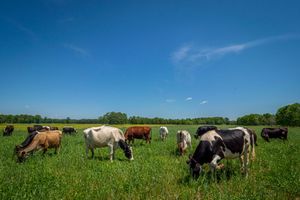2023 Changes to Dairy Revenue Protection Explained
Disaster-impacted dairy producers now have improved flexibility as part of a key policy change for Dairy Revenue Protection (DRP) insurance. USDA recently announced two changes that improve coverage and clarity as well as two additional clarifications.”\n\r”
Continued coverage during disasters
As many as 3.7 million gallons of milk per day were lost to involuntary dumping at the peak of the COVID-19 pandemic in 2020. Less than a year later, devastating wildfires shut down creameries in the Western U.S., blocking dairy producers from marketing their milk.
Whether it’s supply-chain obstacles or natural disasters impacting the dairy value chain, help has arrived for dairy producers who could be forced to dump milk.
 New for 2023, DRP coverage will now have added flexibility for producers to continue coverage when experiencing a disaster at their dairy operation.
New for 2023, DRP coverage will now have added flexibility for producers to continue coverage when experiencing a disaster at their dairy operation.
“This change will have the biggest positive impact for dairy producers who choose DRP,” says Jacqueline Da Rocha, a senior district manager for ProAg. “With all of the uncertainty surrounding weather events and supply-chain challenges, dairy producers have more answers now than ever before.”
So how does a disaster-impacted producer go about leveraging the additional coverage? A producer reports a disaster within 72 hours of its occurrence and shares a letter from their creamery stating they had to dump milk. The insurer will then leverage historical data and the premium paid to determine an indemnity amount. Any indemnity paid is limited to the amount of premium.”\n\r”
Set termination date
USDA also revised policy language to clarify that June 30 will be the set termination date for DRP policies. This long-awaited announcement provides clarity for dairy producers and insurers across the country.
“This has always been a question since DRP started,” says Da Rocha. “Having a specific term date will eliminate confusion as to when the payment is due. In the past, producers have inadvertently missed payments leading to policies being canceled.”
Additional updates
Two additional policy revisions from the USDA regarding DRP coverage include:
- Sales will be suspended during the sales period for situations that arise in which market conditions adversely change after the fact.
“If milk markets start limiting up, DRP sales may be suspended,” says Da Rocha. “It can also happen in the event of news reports or announcements during or after hours that result in significantly altered conditions from when the rates were produced.” Sales can also be suspended when markets limit down – which is something that producers need to be aware of as they consider purchasing a DRP policy.
- A clarification was also added stating an insured cannot have another livestock insurance policy on the same milk in the same quarterly insurance period.
 While this language has always been a part of the DRP policy, and it is common in livestock policies, this clarification is helpful for producers who are already leveraging livestock insurance. It essentially states that a producer cannot have a Livestock Gross Margin (LGM) policy with target marketings in effect while also having a DRP endorsement during those same months insuring the same milk.
While this language has always been a part of the DRP policy, and it is common in livestock policies, this clarification is helpful for producers who are already leveraging livestock insurance. It essentially states that a producer cannot have a Livestock Gross Margin (LGM) policy with target marketings in effect while also having a DRP endorsement during those same months insuring the same milk.
“If you have a duplicate policy and it’s intentional, you could be subject to sanctions with other crop insurance policies,” says Da Rocha. “Understand that you can still have Dairy Margin Coverage (DMC) through USDA’s Farm Service Agency (FSA) program, but you cannot have an LGM policy with target marketings in the same months as the purchased DRP endorsement covering the same milk.” DMC can serve as a great complement to DRP, and Da Rocha encourages a grower to work with their insurance agent to determine the best option for their dairy operation.
DRP Value
Still on the fence about if DRP is right for your operation? Consider the following:
The DRP program is very customizable, enabling the producer to insure any amount of their milk at a price they feel most comfortable with.
In addition to the leverage the policy provides, “With milk markets having taken a beating these last few months, DRP is an option for producers right now to protect their operation as a risk-management tool,” says Da Rocha. “I cannot stress enough that DRP is there to help manage risk.”
Want a deeper dive into DRP?
Visit our DRP resources page or contact your local ProAg agent to help decide what level of coverage is best for your operation.
